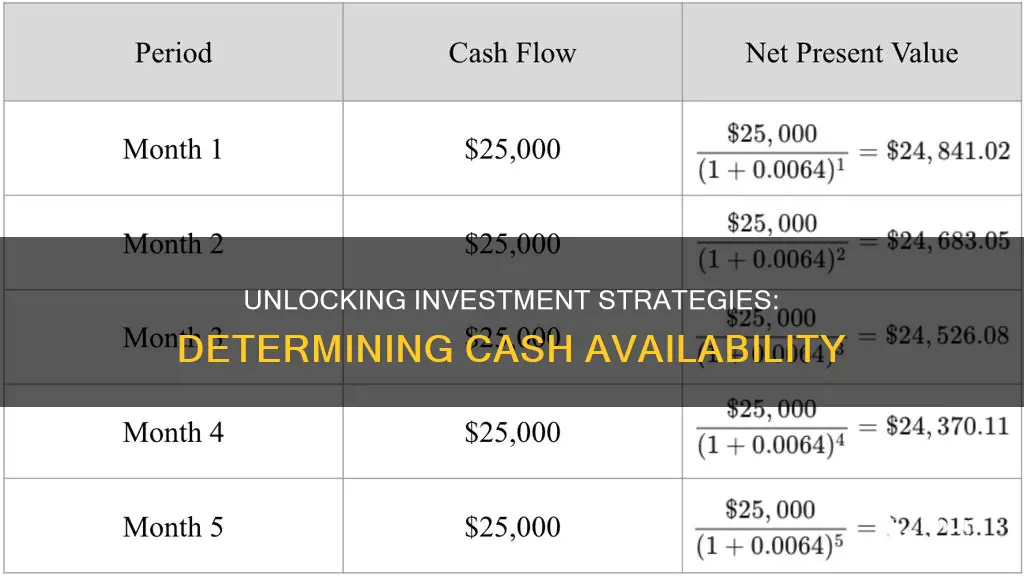
A cash flow statement is a crucial financial statement that provides insights into a company's financial health and operational efficiency. It summarises the inflow and outflow of cash, indicating how well a company manages its cash position and generates cash to meet its financial obligations. This statement is divided into three main sections: cash flow from operations, cash flow from investing activities, and cash flow from financing activities. The cash flow from investing activities is of particular interest when determining the cash available for investment. This section includes any sources and uses of cash from a company's investments, such as purchases or sales of assets, loans made or received, and payments related to mergers and acquisitions. By analysing this section, investors can gain a clear picture of the company's financial stability and make informed investment decisions.
| Characteristics | Values |
|---|---|
| Net cash flow | Total cash inflows – Total cash outflows |
| Operating cash flow | Net income + Non-cash expenses – Change in working capital |
| Cash flow from financing activities | Cash inflows from issuing equity or debt – (Dividends paid + Repurchase of debt and equity) |
| Cash flow from investing activities | Purchase/Sale of property and equipment + Purchase/Sale of other businesses + Purchase/Sale of marketable securities |
| Free cash flow | Net income + Non-cash expenses – Change in working capital – Capital expenditure |
| Brokerage account value | Total dollar worth of all the holdings of the account |
| Brokerage account cash value | Total amount of liquid cash in the account, available for immediate withdrawal or use |
| Brokerage account purchasing power | Amount an investor has to buy securities, consisting of cash, account equity, and available margin (money they can borrow) |
What You'll Learn

Cash flow from operating activities
The cash flow from operating activities can be calculated using two methods: the indirect and direct methods. The indirect method, favoured by many accountants, starts with the net income from the income statement and then adds back non-cash items to arrive at a cash basis figure. The formula for this method is:
> Cash Flow from Operating Activities = Net Income + Non-Cash Items + Changes in Working Capital
Non-cash items include depreciation, amortization, depletion, deferred taxes, investment tax credit, and other funds. Changes in working capital take into account adjustments to accounts receivable, liabilities, inventories, and other operating activities.
The direct method, on the other hand, tracks all transactions in a period on a cash basis and uses actual cash inflows and outflows on the cash flow statement. Examples of the direct method include salaries paid to employees, cash paid to vendors and suppliers, cash collected from customers, interest income, dividends received, and income tax and interest paid.
A positive operating cash flow indicates that a company is performing well in its core business operations and is generating cash. This cash can then be used for shareholder returns, financing arrangements, or capital projects. On the other hand, a negative operating cash flow suggests that the day-to-day operations of the company are losing cash and require additional funding to continue running.
Overall, the cash flow from operating activities is an essential tool for assessing a company's financial performance and making informed investment decisions. It provides insights into the company's ability to generate cash from its core operations and helps investors understand the financial stability and potential of the business.
Creating a Cash Flow for Investing: A Beginner's Guide
You may want to see also

Cash flow from investing activities
Types of Investing Activities
Investing activities can include:
- The purchase of physical assets, such as property, plant, and equipment (PP&E), also known as capital expenditures.
- The purchase of investments, such as stocks, bonds, or other securities.
- The sale of fixed assets or investment securities.
- Proceeds from the sale of businesses or companies (divestitures).
- Collection of loans and insurance proceeds.
Calculating Cash Flow from Investing Activities
To calculate the cash flow from investing activities, you can use the following formula:
CFI = Purchase/Sale of Property and Equipment + Purchase/Sale of Other Businesses + Purchase/Sale of Marketable Securities
Alternatively, you can calculate the net cash flow from investing activities by summing up the positive and negative investing activities listed on the cash flow statement.
Importance of Cash Flow from Investing Activities
It is important to note that negative cash flow from investing activities does not necessarily indicate poor financial health. It often signifies that the company is investing in assets, research, or other long-term development activities that are crucial for the company's health and continued operations.
Extra Cash: Smart Investment Strategies for Beginners
You may want to see also

Cash flow from financing activities
The formula for calculating cash flow from financing activities is as follows:
> Cash Flow from Financing = Cash Inflows from Issuing Equity or Debt – (Dividends Paid + Repurchase of Debt and Equity)
This formula takes into account the cash inflows from issuing equity or debt and subtracts the cash outflows from dividend payments and the repurchase of debt and equity.
For example, let's consider a company with the following financing activities:
- Cash inflows from issuing equity or debt: $150,000
- Dividends paid: $20,000
- Repurchase of debt and equity: $50,000
Using the formula, the calculation would be:
> Cash Flow from Financing = $150,000 – ($20,000 + $50,000) = $80,000
So, the cash flow from financing activities for this company would be $80,000.
It's important to note that cash flow from financing activities is just one part of the overall cash flow statement, which also includes cash flow from operations and cash flow from investing activities. Together, these sections provide a comprehensive view of the company's financial health and liquidity.
Cash or Invest: Where Should Your Money Go?
You may want to see also

Liquidity
A company's liquidity can be assessed by examining its cash flow statement, which provides a detailed breakdown of cash inflows and outflows over a specific period. This statement includes information on cash flow from operations, investing activities, and financing activities.
The cash flow from investing activities is particularly relevant to liquidity. It includes cash inflows from the sale of assets, businesses, and securities, as well as outflows from the purchase of fixed assets, other businesses, and marketable securities. A positive cash flow from investing activities indicates that the company is generating cash from these activities, which can be used to meet short-term obligations.
Additionally, liquidity can be influenced by the timing of transactions. For example, a company may have earned revenue but not yet received the actual cash, or it may have recorded a sale but not received payment immediately. This discrepancy between earnings and cash flow is crucial to consider when assessing a company's liquidity.
Overall, by analyzing the cash flow statement and considering the timing of transactions, investors and analysts can gain insights into a company's liquidity and make informed decisions about its financial health and stability.
Pension Plans: Cash, Investments, and Your Retirement Future
You may want to see also

Net cash flow
To calculate net cash flow, you simply subtract the total cash outflow from the total cash inflow.
Alternatively, you can calculate net cash flow by adding together the total values of three variables that already account for cash inflows and outflows:
Operating cash flow gives a picture of the company's ability to generate cash from its normal operations. It can be calculated using the following formula:
Operating Cash Flow = Net Income + Non-Cash Expenses – Change in Working Capital
Cash flow from financing activities reflects the company's financing mix and is the net flow of cash between the company and its owners, creditors, and investors. This can be calculated as follows:
Financing Cash Flow = Cash Inflows From Issuing Equity or Debt – (Dividends Paid + Repurchase of Debt and Equity)
Cash flow from investing activities is the net cash inflow or outflow from capital expenditures, mergers and acquisitions, and the purchase or sale of marketable securities. This can be calculated using the following formula:
Cash Flow from Investing Activities = Purchase/Sale of Property and Equipment + Purchase/Sale of Other Businesses + Purchase/Sale of Marketable Securities
Cash Flow Analysis: Key to Investment Decision-Making
You may want to see also
Frequently asked questions
Cash flow is the difference between all the company's cash inflows and outflows in a given period. Cash flow from investing activities is the net cash inflow or outflow from capital expenditures, mergers and acquisitions, and the purchase or sale of marketable securities.
To calculate cash flow from investing activities, add the purchases or sales of property and equipment, other businesses, and marketable securities. You can find these items listed in a cash flow statement.
Money market accounts (MMAs) and certificates of deposit (CDs) are examples of cash investments.







